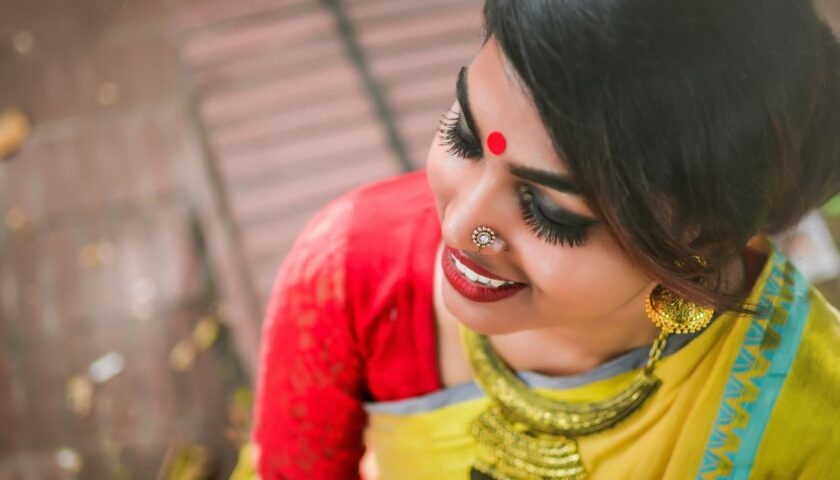Sarees are probably the most standard conventional clothes objects worn by ladies all through India and elements of South Asia. The saree is made up of assorted materials, every with its personal distinctive qualities and traits. From silks to cottons to georgettes, there’s all kinds of supplies used to make sarees. On this article, we’ll discover the various kinds of materials utilized in making sarees and the way they differ from each other. We’ll additionally talk about the benefits and downsides of every sort so you may select the perfect material in your subsequent saree buy.
Several types of saree materials

Sarees are historically constituted of a wide range of completely different materials, every with its personal distinctive traits. The commonest saree materials are silk, cotton, and polyester.
Silk is the preferred material for sarees, as it’s gentle and has an expensive really feel. It is usually recognized for its sturdy and sturdy properties, making it perfect for on a regular basis put on. Cotton sarees are additionally standard, as they’re comfy and breathable. Polyester sarees are much less frequent, however they’re usually cheaper than silk or cotton sarees.
Execs and cons of various saree materials
Completely different saree materials have completely different execs and cons. Here’s a temporary overview of among the hottest saree materials, that will help you select the proper one for you:
1. Cotton sarees are gentle and comfy, making them perfect for heat climate. They’re additionally comparatively cheap. Nonetheless, cotton sarees can wrinkle simply and will require particular care when washing.
2. Silk sarees are luxurious and stylish, however might be fairly costly. They’re additionally delicate and require cautious dealing with.
3. Artificial sarees are normally cheaper than silk sarees, and they’re simpler to take care of. Nonetheless, they will not be as comfy to put on in scorching climate, as they will lure warmth extra simply than pure materials.
4. Georgette sarees are excellent alternative for summers and spring season due to the breathable property and simple to deal with whereas caring and storing. Nonetheless, embellished sarees in georgette materials requires delicate cleansing similar to dry cleansing and correct storage.
5. Linen sarees are gentle and ethereal, making them perfect for heat climate put on. They will wrinkle simply, nonetheless, so they could require particular care when packing or storing them.
Which saree material is finest for which event?

Completely different saree materials are used for various events. The commonest materials used for sarees are silk, cotton, and polyester.
Silk is the costliest and splendid material used for sarees. It’s excellent for particular events like weddings and events. Silk sarees are additionally thought of to be very fortunate and are sometimes gifted to new brides.
Cotton is a extra informal material than silk and is normally used for on a regular basis put on. Cotton sarees are comfy and breathable, making them perfect for decent climate situations.
Polyester is an artificial material that’s cheaper than silk or cotton. Polyester sarees are sometimes brightly colored and might be embellished with sequins or different elaborations. They’re excellent for festivals and different particular events.
Learn how to take care of various kinds of saree materials

Completely different saree materials require completely different ranges of care. For instance, a silk saree needs to be dry-cleaned, whereas a cotton saree might be machine or hand washed. Here’s a information to caring for various kinds of saree materials:
Silk: Silk is a fragile material and needs to be dry-cleaned. When you should wash a silk saree at dwelling, accomplish that by hand in cool water with a gentle detergent. Dangle the saree to dry within the shade, and iron it on the bottom setting when it’s barely damp.
Cotton: Cotton is a sturdy material that may be machine-washed. Nonetheless, in case your saree has intricate embroidery or elaborations, it’s best to hand-wash it or have it dry-cleaned to keep away from harm. Machine-wash cotton sarees on a mild cycle in cool water with a gentle detergent, and cling them to dry within the shade. Iron them on the very best setting when they’re fully dry.
Linen: Linen is a robust material that may be machine-washed. Nonetheless, like cotton, in case your linen saree has intricate particulars, it’s best to hand-wash it or have it dry-cleaned. Machine-wash linen sarees on a mild cycle in cool water with a gentle detergent, and cling them to dry within the shade. Iron them on the very best setting when they’re fully dry.
Crepe: Crepe is an artificial material usually worn in all seasons. It wants dry cleansing, as washing it at dwelling would possibly harm the material. Nonetheless, in some instances it may be washed by hand in chilly water. Don’t wring crepe sarees to avod material harm.
Conclusion
Sarees are probably the most standard clothes objects in India and have been worn for hundreds of years in each conventional and informal occasions. Ladies in India adorn sarees as a delight and a part of their cultural values and rituals. Over time, completely different materials have been used to make sarees. These materials embody cotton, silk, satin, georgette, crepe and chiffon. Every material has its personal distinctive properties and drapes in a different way when worn. Some are wealthy in textures and really feel whereas some are made to make you’re feeling relaxed and comfy.

